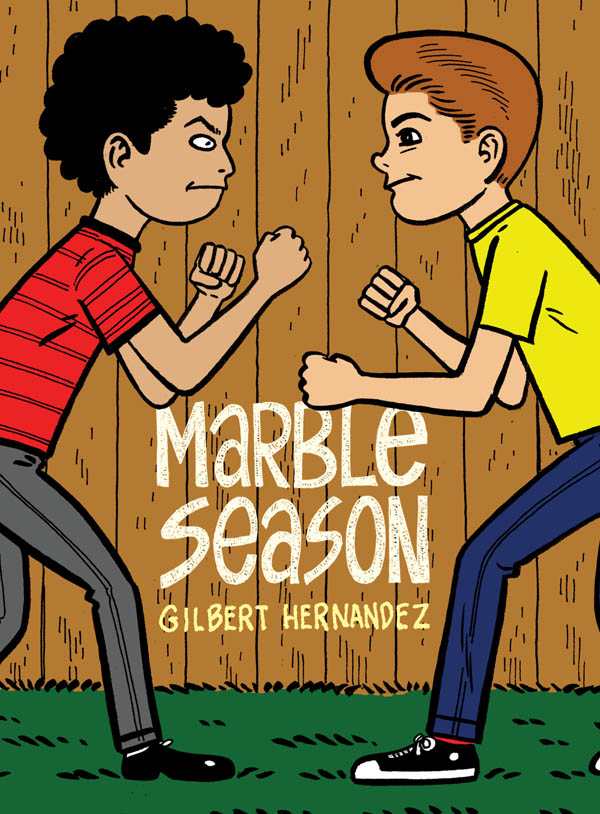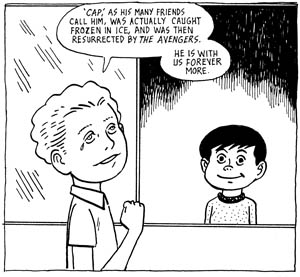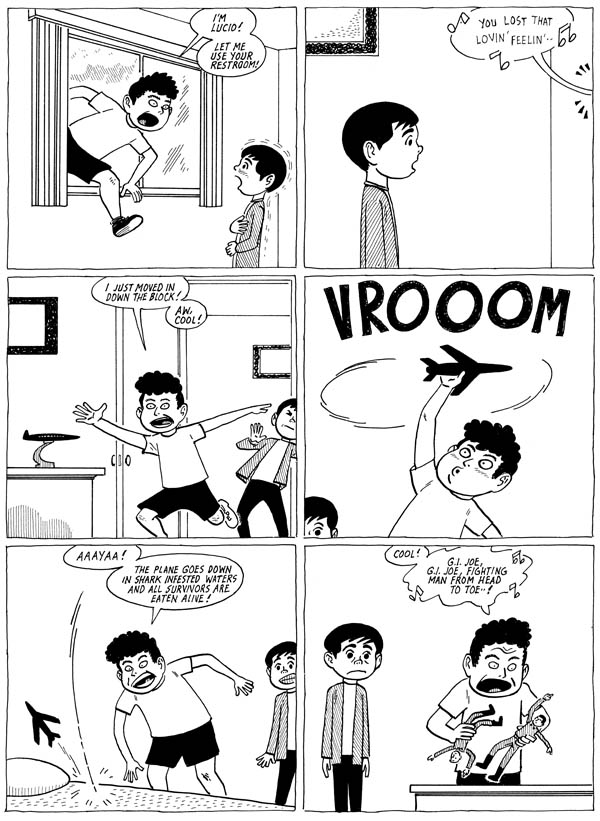 Home > CR Reviews
Home > CR Reviews Marble Season
posted March 19, 2013
Marble Season
posted March 19, 2013

 Creator:
Creator: Gilbert Hernandez
Publishing Information: Drawn and Quarterly, Hardcover, 128 pages, May 2013, $21.95.
Ordering Numbers: 1770460861 (ISBN10), 9781770460867 (ISBN13)
One of the best comics moments in recent years comes at the conclusion of Gilbert Hernandez's
Marble Season, the prolific cartoonist's latest book and his first with Drawn And Quarterly. A boy named Huey -- the author's stand-in -- talks to a near- or same-age neighborhood peer named Patty as they move through their shared neighborhood. Their conversation ranges from the ordinary to the wistful, and includes a memorable instance of physical interplay centered on a hurt knee. Despite spending so much time with Huey at this point in the book, we haven't seen him interact with anyone in this way, at least not for this extended period of time. It feels at once like a very real conversation two kids might have and an idealized version of the same. It feels hushed and surprisingly memorable. The setting registers as real to us at this point while also recalling every minimalist childhood landscape from comics past.

A lot of
Marble Season dances along that fine line between delicate abstraction and intimately-observed banalities, mirroring the childhood experience of rhythms and routines and long stretches of boredom between peak moments, all set in a shifting latticework of relationships based on power and influence. It's entirely possible to march through
Marble Season just picking up on experiences common to one's own childhood, like the shape of play directed by a creative child that wants to achieve a very specific experience but hasn't quite figured out how to do so, or what it's like to let into your life one of those loud, furious, forces of nature that you may not even like as much as come to enjoy their energy and lack of focus. Greater rewards make themselves available to those that look past the specifics and focus on the ways these events break across young Huey's emerging self-conception, how various circumstances crash against the kind of wistful dissatisfaction that drives so many deep-thinking children. Huey comes across as very lonely, and slightly insecure, and it's easy to root for him. When Huey declares he hopes he likes being an adult, it's difficult not to smile smile because so frequently a character like that one knows only that they hate being a child.
Marble Season strikes me as an accessible work, astonishing only in that I find Gilbert Hernandez the most routinely baffling of the great cartoonists. I frequently throw up my hands in frustration over some story or another, some strategy or approach, even specific storytelling choices, completely convinced that the cartoonist gone off of the deep end and into a pool of self-indulgent excess. Hernandez has never failed to talk me back over and onto his side by any story or story cycle's end. Still, that initial impulse recurs. It's absent from
Marble Season. This is a very straight-forward work in certain ways: the characters are clearly delineated and expressive, each page is a six-panel grid, the backgrounds are clean yet never overwhelm, and the pacing never crashes ahead of the reader's need for clarity. It's a good place to start if you haven't visited with the cartoonist for a while, or been put off by showier works.
I've read
Marble Season multiple times already. I read it once compulsively for an idea of its basic narrative, again in pieces to soak in scenes and character arcs, once just to look at the art, and one more time to reflect on the kids depicted here in relation to other children Hernandez has drawn in the past. The kids in
Marble Season are more similar than dissimilar to that first generation of kids in the Palomar stories for which Hernandez is best known, despite vastly different circumstances. With each group of young people the cartoonist is able to focus on very specific experiences and the way each one might potentially shape alliances, partnerships, rivalries and even romances among the kids in question. It's a vision of childhood as an expanse of skin, full of bruises that might deepen and turn color with time. By cutting his narrative short, by avoiding making it a moment of time with a beginning and end, Hernandez sends us scrambling back to figure out childhood from the child's perspective, where even the shallowest art defines self. It's a benign, lovely, encouraging view of that time in our lives, and a tribute to those that have made this journey before Hernandez did.
Marble Season is a formidable work from one of our best cartoonists. It's Beto's year.



